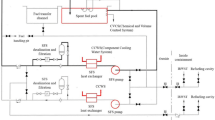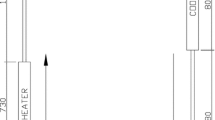Abstract
This paper proposes a design of passive cooling system for CPR1000 spent fuel pool (SFP). Our design can effectively manage the SFP temperature not to exceed 80 °C. Then the transient analysis of the CPR1000 SFP with designed passive cooling system is carried out in station blackout (SBO) accident by the best-estimate thermal-hydraulic system code RELAP5. The simulation results show that to maintain the temperature of CPR1000 SFP under 80 °C, the numbers of the SFP and air cooling heat exchangers tubes are 6627 and 19 086, respectively. The height difference between the bottom of the air cooling heat exchanger and the top of the SFP heat exchanger is 3.8 m. The number of SFP heat exchanger tubes decreases as the height difference increases, while the number of the air cooling heat exchanger tubes increases. The transient analysis results show that after the SBO accident, a stable natural cooling circulation is established. The surface temperature of CPR1000 SFP increases continually until 80 °C, which indicates that the design of the passive air cooling system for CPR1000 SFP is capable of removing the decay heat to maintain the temperature of the SFP around 80 °C after losing the heat sink.












Similar content being viewed by others
Abbreviations
- k :
-
Total heat transfer coefficient W/(m2 K)
- d i :
-
Tube inner diameter (m)
- d o :
-
Tube outside diameter (m)
- h i :
-
Tube inner heat transfer coefficient W/(m2 K)
- h o :
-
Tube outside heat transfer coefficient W/(m2 K)
- η f :
-
Heat rejection efficiency of fins
- λ :
-
Heat conduction coefficient W/(m2 K)
- A i :
-
Total internal surface area of the heat exchanger (m2)
- A h :
-
Total external surface area of the heat exchanger (m2)
- A f :
-
Total surface area of the fins (m2)
- A r :
-
External surface area except the fin surface area (m2)
- Φ:
-
Heat transfer power (W)
- ΔT m :
-
Logarithmic mean temperature difference
- Nu:
-
Nusselt number
- Gr:
-
Grashof number
- Pr:
-
Prandtl number
- g :
-
Gravitational acceleration (m/s2)
- l :
-
Tube length (m)
- α v :
-
Expansion coefficient (1/K)
- ν :
-
Kinematic viscosity (m2/s)
- T w :
-
Wall temperature (K)
- T ∞ :
-
Water average temperature (K)
- H :
-
Height of the interlayer (m)
- δ :
-
Thickness of the interlayer (m)
- f :
-
Friction factor
- De :
-
Equivalent diameter (m)
- u :
-
Fluid velocity (m/s)
- u 1 :
-
Velocity in the upstream (m/s)
- u 2 :
-
Velocity in the downstream (m/s)
- A 1 :
-
Upstream area (m2)
- A 2 :
-
Downstream area (m2)
- F t :
-
Structure correction factor
- N s :
-
The number of serial heat exchangers
- N p :
-
The number of tube passes
- u 3 :
-
Velocity in the tube (m/s)
- Δh :
-
The height difference between the top of the SFP heat exchanger and the bottom of the air cooling heat exchanger (m)
- T in :
-
Inlet temperature of the heat exchanger (°C)
- T out :
-
Outlet temperature of the heat exchanger (°C)
- T i :
-
Inner tube wall temperature of the heat exchanger (°C)
- T o :
-
Outer tube wall temperature of the heat exchanger (°C)
- G :
-
Mass flow of the passive cooling loop (kg/s)
- Q :
-
Decay heat (MW)
References
T. Schulz, Westinghouse AP1000 advanced passive plant. Nucl. Eng. Des. 236, 1547–1557 (2006). doi:10.1016/j.nucengdes.2006.03.049
T. Zhou, J. Li, X. Ru et al., Application and development of passive technology in nuclear power units. Proc. CSEE 33, 81–89 (2013)
P. Juhn, J. Kupitz, J. Cleveland et al., IAEA activities on passive safety systems and overview of international development. Nucl. Eng. Des. 201, 41–59 (2000). doi:10.1016/S0029-5493(00)00260-0
A. Achilli, G. Cattadori, R. Ferri et al., Two new passive safety systems for LWR applications. Nucl. Eng. Des. 200, 383–396 (2000). doi:10.1016/S0029-5493(00)00256-9
S. Carlos, F. Sanchez-Saez, S. Martorell, Use of TRACE best estimate code to analyze spent fuel storage pools safety. Prog. Nucl. Energy 77, 224–238 (2014). doi:10.1016/j.pnucene.2014.07.008
S. Chen, W. Lin, Y. Ferng et al., CFD simulating the transient thermal–hydraulic characteristics in a 17 × 17 bundle for a spent fuel pool under the loss of external cooling system accident. Ann. Nucl. Energy 73, 241–249 (2014). doi:10.1016/j.anucene.2014.06.054
H. Wang, L. Ge, J. Shan et al., in ICONE21-16503: Safety Analysis of CPR1000 Spent Fuel pool in case of Loss of Heat Sink, The 21st International Conference on Nuclear Engineering (ICONE21), Chendu, China, July 29–August 2 (2013)
B. Arndt, R. Klaus, K. Wasinger, in IAEA-CN-102/17: Advanced Spent Fuel Storage Pools. Storage of Spent Fuel from Power Reactors, Storage of Spent Fuel from Power Reactors 2003 Conference (IAEA-CSP-20), Vienna, Austria, June 2–6 (2003)
Westinghouse Electric Company. Modular Floating Passive Cooling System 300 for Used Fuel Pools. American (2011)
C. Ye, M. Zheng, M. Wang et al., The design and simulation of a new spent fuel pool passive cooling system. Ann. Nucl. Energy 58, 124–131 (2013). doi:10.1016/j.anucene.2013.03.007
Y. You, A. Fan, S. Huang et al., Numerical modeling and experimental validation of heat transfer and flow resistance on the shell side of a shell-and-tube heat exchanger with flower baffles. Int. J. Heat Mass Transf. 55, 7561–7569 (2012). doi:10.1016/j.ijheatmasstransfer.2012.07.058
Y. You, A. Fan, X. Lai et al., Experimental and numerical investigations of shell-side thermo-hydraulic performances for shell-and-tube heat exchanger with trefoil–hole baffles. Appl. Therm. Eng. 50, 950–956 (2013). doi:10.1016/j.applthermaleng.2012.08.034
S. Yang, W. Tao, Heat Transfer, vol. 1 (Higher Education Press, Beijing, 1998), p. 239
V. Ransom, J. Trapp, R. Wagner, RELAP5/MOD3. 3 Code Manual Volume IV: Models and Correlations. NUREG/CR-5535/Rev 1. Idaho National Engineering Laboratory (2001)
R. Siegel, R. Norris, Tests of free convection in a partially enclosed space between two heated vertical plates. Trans. ASME 79, 663 (1957)
Acknowledgments
The study of this paper is financially supported by National High-tech R&D Program of China (No. 2012AA050905). We would like to express our heartily gratitude to its support and funding. And we would also greatly appreciate all assistances from the China Nuclear Power Technology Research Institute (CNPRI), who provided valuable comments and relevant information.
Author information
Authors and Affiliations
Corresponding author
Rights and permissions
About this article
Cite this article
Ge, L., Wang, HT., Zhang, GL. et al. Thermal-hydraulic design and transient analysis of passive cooling system for CPR1000 spent fuel storage pool. NUCL SCI TECH 27, 8 (2016). https://doi.org/10.1007/s41365-016-0017-6
Received:
Revised:
Accepted:
Published:
DOI: https://doi.org/10.1007/s41365-016-0017-6




